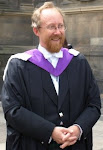We were reunited with the coach and driver who had brought us from Tel Aviv airport to Jerusalem, which seemed so long ago, but was only 3 days previously.
We drove alongside the Security Barrier for part of the journey to Hebron and this emphasised the divisions between the communities that were to be so evident throughout the day. We passed through army checkpoints on several occasions, both on the bus, and in Hebron itself, on foot too.
Perhaps because of the tension in the air I did not take any photos in Hebron itself. We were accompanied by two Ecumenical Accompaniers from the WCC mission. They guided us through the checkpoints, and showed us some of the scenes where conflict had taken place. To provide a security buffer between one of the Jewish Settlements and the surrounding Palestinian community, one of the streets was closed to Palestinians. Those who live in houses on this street have to use the rear entrances to their houses. The street front was deserted, although previously it had been one of the main streets passing the most popular Suk in the town.
After passing along this eerily silent street, we exited the security zone and visited the Suk. Most of the shops were now shuttered or abandoned. But we did our best to give the shops that were open our trade. I bought a decorated plate showing the building which makes this town a place of pilgrimage for both Moslems and Jews. The Tomb of Abraham contains the sepulchres of Abraham & Sarah, Isaac & Rebecca, and Jacob and Rachel.
 But my plate is now symbolic of these two communities. It is fractured and divided into pieces. I did not adequately pack it in my suitcase. These two communities, once part of the same family, have allowed their cracks to widen into gaping fissures that seem beyond the power of man to restore. Let us strive to help both comunities to accept each other and to learn to live together in peace.
But my plate is now symbolic of these two communities. It is fractured and divided into pieces. I did not adequately pack it in my suitcase. These two communities, once part of the same family, have allowed their cracks to widen into gaping fissures that seem beyond the power of man to restore. Let us strive to help both comunities to accept each other and to learn to live together in peace.The Sepulchre has been divided into two portions, the Islamic part containing the tombs of Isaac and Rebecca, and the Jewish part containing the tombs of Jacob and Rachel. The tombs of Abraham and Sarah are in the centre, visible to both sides, but accessible to neither. The ancient wooden Islamic pulpit was made in Ashqelon in 1091, and is similar to the pulpit in Jerusalem that was destroyed by a deranged Christian arsonist in 1969.
As we left Hebron, the road was blocked by Israeli Army vehicles seeking to arrest a Palestinian. The road was covered with stones and bricks that the local people had been throwing at the vehicles. Our bus had to turn round and find another way to Bethlehem. Not only was the detour longer but we had to pass through another army checkpoint.

The doorway into the Church of the Nativity was easier for some of our party to enter than others! The varied stonework is evidence of the turbulent history of the building. Murphy O'Connor notes that the lintel shading the top of my photo is of the 6th century entrance, the doorway being reduced in size to the medieval arched entrance, and further shrunk to its present size in the Mamluk/Ottoman period.


Inside the building the ornate decoration of the Greek Orthodox tradition fronts remnants of elegant mosaic work on the walls and floors, with painted columns. To the left of the Orthodox dais is a portion of the sanctuary used by Armenian worshippers. We were there the day before Orthodox Pentecost and several Armenian Clergy were singing their way through the special liturgy for the day. The crypt and cave below the church was blackened with the soot of candles and could have been anywhere despite being venerated as the birthplace of Jesus for the past 2000 years.

On the opposite side of Bethlehem Square is the mosque. It too has had many alterations, its minnaret being repaired just a few years ago after it developed some rather ominous cracks.
 On the way back to Jerusalem we stopped at Solomon's Pools. Although given Solomon's name, these reservoirs were built around the 2nd century BC. The area has the closest springs to Jerusalem at a higher level than the city. The reservoirs feed an aqueduct and tunnel water system running for 21.5km North to the Temple in Jerusalem. The aqueduct level drops only 30m over that distance, 1cm every 7.16m, an impressive feet of engineering.
On the way back to Jerusalem we stopped at Solomon's Pools. Although given Solomon's name, these reservoirs were built around the 2nd century BC. The area has the closest springs to Jerusalem at a higher level than the city. The reservoirs feed an aqueduct and tunnel water system running for 21.5km North to the Temple in Jerusalem. The aqueduct level drops only 30m over that distance, 1cm every 7.16m, an impressive feet of engineering.And so we returned to St. Andrew's in Jerusalem, having in one day visited the Tombs of the Jewish and Arab Patriarchs, dating from 4000-3500 years ago, and the 2000-year old birthplace of Jesus Christ, the Son of God.

No comments:
Post a Comment